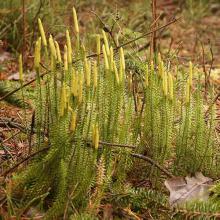Lycopodium clavatum
Common name:
Running clubmoss
Class:
Lycopodiopsida
Phylum:
Lycopodiophyta
Superphylum:
Lycopodium annotinum
Common name:
Stiff club moss
Class:
Lycopodiopsida
Phylum:
Lycopodiophyta
Superphylum:
Lycopodium clavatum
Common name:
Running clubmoss
Class:
Lycopodiopsida
Phylum:
Lycopodiophyta
Kingdom:
Plantae
Lycopodium annotinum
Common name:
Stiff club moss
Class:
Lycopodiopsida
Phylum:
Lycopodiophyta
Kingdom:
Plantae
Lycopodium clavatum
Common name:
Running clubmoss
Class:
Lycopodiopsida
Phylum:
Lycopodiophyta
Lycopodium annotinum
Common name:
Stiff club moss
Class:
Lycopodiopsida
Phylum:
Lycopodiophyta
Phylum (Plantae): Lycopodiophyta
The lycophytes, when broadly circumscribed, are a vascular plant (tracheophyte) subgroup of the kingdom Plantae. They are sometimes placed in a division Lycopodiophyta or Lycophyta or a subdivision Lycopodiophytina. They are one of the oldest lineages of extant (living) vascular plants; the group contains extinct plants that have been dated from the Silurian (ca. 425 million years ago). Lycophytes were some of the dominating plant species of the Carboniferous period, and included tree-like species, although extant lycophytes are relatively small plants.
The scientific names and the informal English names used for this group of plants are ambiguous. For example, "Lycopodiophyta" and the shorter "Lycophyta" as well as the informal "lycophyte" may be used to include the extinct zosterophylls or to exclude them.
Distribution
Lycophytes reproduce by spores and have alternation of generations in which (like other vascular plants) the sporophyte generation is dominant. Some lycophytes are homosporous while others are heterosporous. When broadly circumscribed, the lycophytes represent a line of evolution distinct from that leading to all other vascular plants, the euphyllophytes, such as ferns, gymnosperms and flowering plants. They are defined by two synapomorphies: lateral rather than terminal sporangia (often kidney-shaped or reniform), and exarch protosteles, in which the protoxylem is outside the metaxylem rather than vice versa. The extinct zosterophylls have at most only flap-like extensions of the stem ("enations") rather than leaves, whereas extant lycophyte species have microphylls, leaves that have only a single vascular trace (vein), rather than the much more complex megaphylls of other vascular plants. The extinct genus Asteroxylon represents a transition between these two groups: it has a vascular trace leaving the central protostele, but this extends only to the base of the enation.
Zosterophylls and extant lycophytes are all relatively small plants, but some extinct species, such as the Lepidodendrales, were tree-like, and formed extensive forests that dominated the landscape and contributed to the formation of coal.
Reference: Wikipedia


